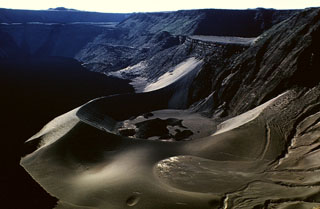Report on Cerro Azul (Ecuador) — 4 June-10 June 2008
Smithsonian Institution / US Geological Survey
Weekly Volcanic Activity Report, 4 June-10 June 2008
Managing Editor: Sally Sennert.
Please cite this report as:
Global Volcanism Program, 2008. Report on Cerro Azul (Ecuador) (Sennert, S, ed.). Weekly Volcanic Activity Report, 4 June-10 June 2008. Smithsonian Institution and US Geological Survey.
Cerro Azul
Ecuador
0.92°S, 91.408°W; summit elev. 1640 m
All times are local (unless otherwise noted)
Based on field observations, the IG reported on 5 June that the initial eruption on 29 May from the SE flank of Cerro Azul issued from three fissures. Six 'a'a lava flows up to 5 m thick flowed rapidly from a fissure near the caldera; one of the flows reached the next fissure at a lower elevation. A 1-km-long fissure in the central part of the flank emitted multiple lava flows up to 15 m thick. Activity at a third fissure at the lower flank, also about 1 km in length, produced cones and several lava flows.
On 3 June, new thermal anomalies on the SE flank detected in satellite imagery increased in intensity and migrated E in later images. Incandescence in the same area was also noted by ground observers. On 4 June an overflight confirmed the presence of a new vent. A fissure about 400-500 m long emitted lava flows that traveled towards the S coast of Isabela. Blocks were ejected about 60 m above the vents. A VAAC report indicated that an eruption plume drifted 50 km N. On 5 June, thermal anomalies were present on satellite imagery.
Geological Summary. Located at the SW tip of the J-shaped Isabela Island, Cerro Azul contains a steep-walled 4 x 5 km nested summit caldera complex that is one of the smallest diameter, but at 650 m one of the deepest in the Galápagos Islands. The shield volcano is the second highest of the archipelago. A conspicuous bench occupies the SW and west sides of the caldera, which formed during several episodes of collapse. Youthful lava flows cover much of the caldera floor, which has also contained ephemeral lakes. A prominent tuff cone located at the ENE side of the caldera is evidence of episodic hydrovolcanism. Numerous spatter cones dot the western flanks. Fresh-looking lava flows, many erupted from circumferential fissures, descend the NE and NW flanks. Historical eruptions date back only to 1932, but Cerro Azul has been one of the most active Galápagos volcanoes since that time. Solfataric activity continues within the caldera.
Source: Instituto Geofísico-Escuela Politécnica Nacional (IG-EPN)

